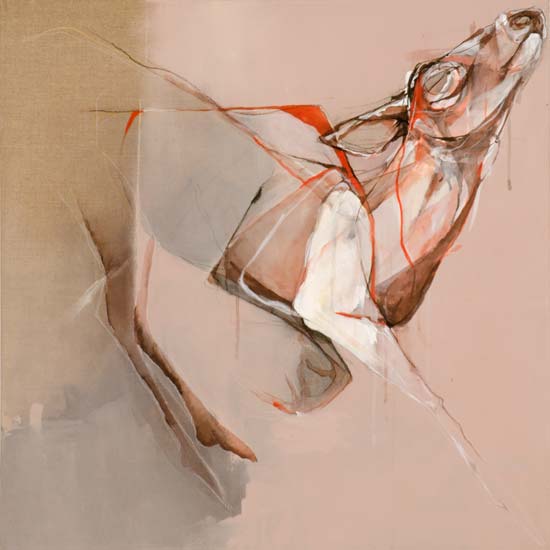
Thoreau’s words, “Know your own bone; gnaw it, bury it, unearth it, and gnaw it still” inform Carolyn V Watson’s conceptualisation and absolute rigour of process in producing “intimately veiled” paintings and “scorched raw” sculptural pieces. With anthropomorphic intent, her anatomically imperfect feral animals are the embodiment of flawed humanity’s foibles and deepest longings.
Ancient beliefs held that the essence of a person was contained in the bones. For Brisbane-based and QCA trained Watson, they represent something enduring in the passing of time – the possessing or coming to terms with one’s own past histories. “The use of bones as a base material is a readily identifiable metaphor,” she muses. “It’s about knowing ourselves, every bulbous, gnarled memory, and accepting the repercussions of our actions and embracing the gift of regret.”
There is a strangely unsettling quality to Watson’s works – one that positively urges engagement. The survival instinct of species alien to new environment finds parallel with our own behavioural patterns when adrift in unfamiliar territory; selective, destructive, adaptive. A curious paradox presents itself as Watson portrays the existential predicament of her empathically termed “stoic thieves”. “I want there to be a quiet tenderness within these works that is beyond the immediate surface,” offers Watson.
The evidence of process and a respect for the handmade is an integral component in all of Watson’s works. There is nothing instantaneous in her practice. “It has always been an emotional title-fight of persistence,” she says, “and a discipline to not go the easy way or use a simple card trick to bring the work to an end.” Watson describes her mixed media drawings on linen as being like ‘cave paintings on skin’ where the internal workings are made manifest in an interplay of brutal shedding and delicate accretion. “I work intuitively,” she explains. “The initial drawn line instigates the Chinese whisper. There is a constant re-editing of space as each layer alters its course and grows over or changes with time. The drips of ink that pool are the only evidence of a previous existence.” Two notable elements within the imagery are the exaggeration of the protagonist’s ears and the omission of at least one limb – “the proverbial, something missing”. Other limbs have evolved into human-like hands. Watson’s mutant creatures invite the viewer to consider one’s own vulnerability and pathos.
The same regard for craftsmanship is invested in Watson’s sculptures that are hand-stitched with a “loving maternal patience”. At first encounter the constructions appear jarring. Standing stark on steel-rod legs, their bodies are encased in felt and sheep leather stretched taut and surmounted by real skulls and antlers. As with the drawings, here too anatomy has been granted a poetic license. The absence of ears in these works is intended to heighten audience participation. Without ears the beings are not readily classified – they become ‘other’ – and as such, act as a conduit to personal reflection. Watson’s new sculptures are white. Aside from the connotations of bones, ghosts and the totemic, she explains that she felt a need to move away from the ‘shadow’ aspect of her previous work. White invites a closer scrutiny where the considered dance of thread becomes evident. “The binding of the object has evolved beyond a system of containment,” says Watson. “It now has a linear function and provides a connection between the 2D and 3D work.”
Although Watson’s art is deeply personal, she is reluctant to expound upon the narrative content and underlying symbolism, preferring that the viewer respond instinctively. Her intention is the prompting of a dialogue with these “aching, untamed creatures” and to express “a quiet tenderness that is beyond the immediate surface.” The exhibition owning the bones is the culmination of experience and memory – an uneasy acceptance of “the human habits exhibited in the everyday.” With a defiant black humour, Watson hopes to “elevate our own marks and scars to that of trophy-room pride.”
Receive e-mail updates on our exhibitions, events and more
Subscribe Now